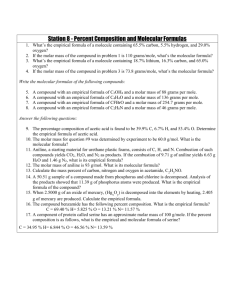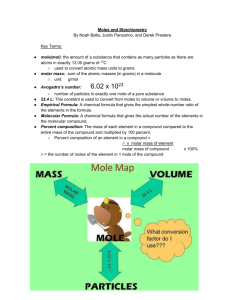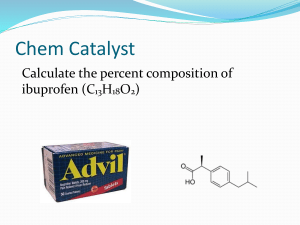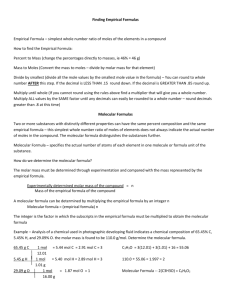notes packet
advertisement
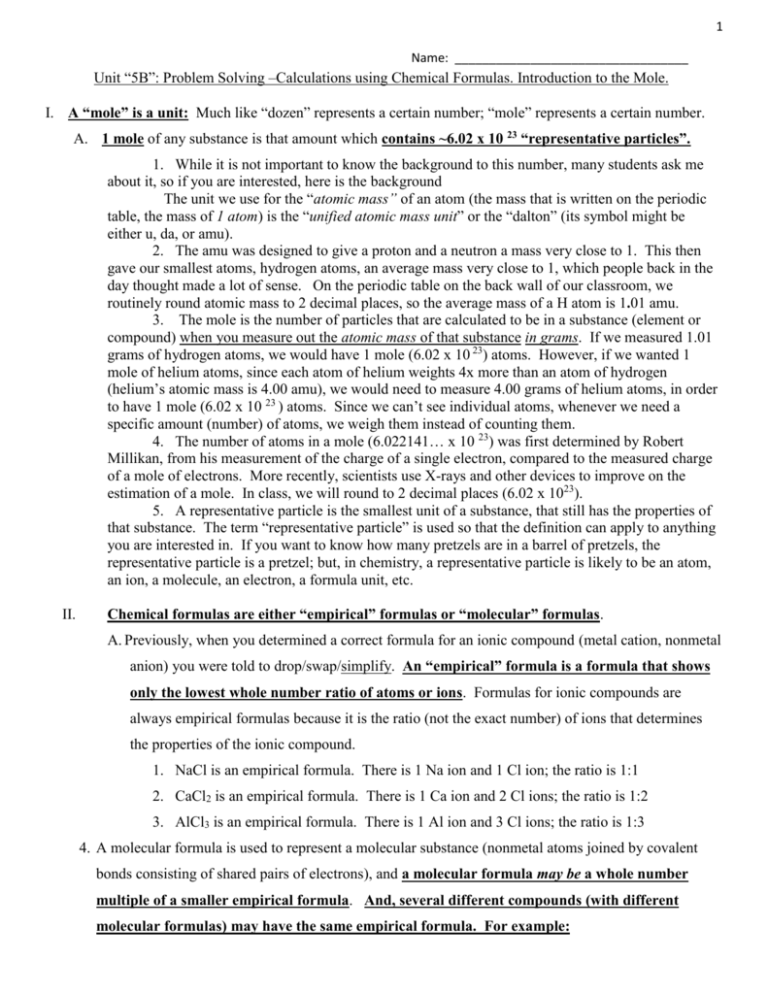
1 Name: __________________________________ Unit “5B”: Problem Solving –Calculations using Chemical Formulas. Introduction to the Mole. I. A “mole” is a unit: Much like “dozen” represents a certain number; “mole” represents a certain number. A. 1 mole of any substance is that amount which contains ~6.02 x 10 23 “representative particles”. 1. While it is not important to know the background to this number, many students ask me about it, so if you are interested, here is the background The unit we use for the “atomic mass” of an atom (the mass that is written on the periodic table, the mass of 1 atom) is the “unified atomic mass unit” or the “dalton” (its symbol might be either u, da, or amu). 2. The amu was designed to give a proton and a neutron a mass very close to 1. This then gave our smallest atoms, hydrogen atoms, an average mass very close to 1, which people back in the day thought made a lot of sense. On the periodic table on the back wall of our classroom, we routinely round atomic mass to 2 decimal places, so the average mass of a H atom is 1.01 amu. 3. The mole is the number of particles that are calculated to be in a substance (element or compound) when you measure out the atomic mass of that substance in grams. If we measured 1.01 grams of hydrogen atoms, we would have 1 mole (6.02 x 10 23) atoms. However, if we wanted 1 mole of helium atoms, since each atom of helium weights 4x more than an atom of hydrogen (helium’s atomic mass is 4.00 amu), we would need to measure 4.00 grams of helium atoms, in order to have 1 mole (6.02 x 10 23 ) atoms. Since we can’t see individual atoms, whenever we need a specific amount (number) of atoms, we weigh them instead of counting them. 4. The number of atoms in a mole (6.022141… x 10 23) was first determined by Robert Millikan, from his measurement of the charge of a single electron, compared to the measured charge of a mole of electrons. More recently, scientists use X-rays and other devices to improve on the estimation of a mole. In class, we will round to 2 decimal places (6.02 x 1023). 5. A representative particle is the smallest unit of a substance, that still has the properties of that substance. The term “representative particle” is used so that the definition can apply to anything you are interested in. If you want to know how many pretzels are in a barrel of pretzels, the representative particle is a pretzel; but, in chemistry, a representative particle is likely to be an atom, an ion, a molecule, an electron, a formula unit, etc. II. Chemical formulas are either “empirical” formulas or “molecular” formulas. A. Previously, when you determined a correct formula for an ionic compound (metal cation, nonmetal anion) you were told to drop/swap/simplify. An “empirical” formula is a formula that shows only the lowest whole number ratio of atoms or ions. Formulas for ionic compounds are always empirical formulas because it is the ratio (not the exact number) of ions that determines the properties of the ionic compound. 1. NaCl is an empirical formula. There is 1 Na ion and 1 Cl ion; the ratio is 1:1 2. CaCl2 is an empirical formula. There is 1 Ca ion and 2 Cl ions; the ratio is 1:2 3. AlCl3 is an empirical formula. There is 1 Al ion and 3 Cl ions; the ratio is 1:3 4. A molecular formula is used to represent a molecular substance (nonmetal atoms joined by covalent bonds consisting of shared pairs of electrons), and a molecular formula may be a whole number multiple of a smaller empirical formula. And, several different compounds (with different molecular formulas) may have the same empirical formula. For example: 2 a. C6H12O6 is the molecular formula for “glucose” (blood sugar). CH2O is its empirical formula. b. CH2O is the molecular formula for “formaldehyde” (embalming fluid). CH2O is its empirical formula. Practice: Circle the empirical formulas in the list below: Al2H6 III. NH3 C 4 H8 CaSO4 P2O5 NaC2H3O2 N2O4 Molar Mass: You should (this year) round to 2 decimal places when calculating molar mass. A. The molar mass is the mass in grams of 1 mole of a substance (element or compound). You will find the molar mass for each element, listed in the element’s square on the periodic table. The molar mass is identical to the element’s atomic mass (except that the unit is different). 1. The unit for “atomic mass” would be one of these: u, da, amu. 2. The unit for “molar mass” (the mass of 1 mole) is “grams” or “g”. B. To calculate the molar mass when given a chemical formula, calculate the sum of the molar masses of the atoms within the given formula. Maintain 2 decimal places. Example: Calculate the molar mass of water H2O = 2 H + 1 O 1.00 + 1.00 + 16.00 = 18.00 grams / mole. C. It is important that you become used to writing the full unit for molar mass: “grams / mole” (spoken: “grams per mole”). This will enable you to understand stoichiometry later this year. D. Whenever you need to use molar mass as a factor: Every numerator and every denominator should have a number, a unit, and a chemical formula. The number that should be placed in front of “mole” is the whole number 1 (with infinite sig figs). The mass in grams is placed on the 1 mole H 2 O opposite side of the division line: 18.00 grams H O 2 18.00 grams H 2 O 1 mole H O 2 or E. Calculating molar mass in a formula with parenthesis…. Multiply the number of each atom within the parentheses by the subscript outside of the parentheses. F. Example: calculate the molar mass of Ca(NO3)2 There is 1 Ca ion and 2 (NO3) ions. The “2” refers only to the (NO3) group; distribute the 2 over the (NO3) but not back to the Ca. I’ve worked the calculation two different ways: Ca(NO3)2 1 Ca + 2 N + Ca(NO3)2 6O 14.01 x 2 = 28.02 = 40.00 + 28.02 + OR: 1 Ca + 2 (NO3) and 16.00 x 6 = 96.00 96.00 = 164.02 grams / mole 2 (14.01 + 48.00) = 124.02 40.00 + 124.02 = 164.02 g/mol 3 IV. Determining the “Percent Composition by Mass” of Each Element in a Compound. A. When given the actual measured mass of the each element used to make a compound, you may do a simple % calculation: (part / total) x 100 for each element. (mass of first element / sum of the 2 masses) x 100 = % by mass for the first element (mass of second element / sum of the 2 masses) x 100 = % by mass for the second element Example: 23.0 grams of Na combines completely with 8.0 grams of O to form a compound. Determine the percent composition of “O” in the compound part x 100 total 16.0 grams (23.0 8.0) grams x 100 16.0 grams 31.0 grams 25.8 % O Practice: 64.0 grams of Cu combines completely with 16.0 grams of S to form a compound. Determine the percent composition of Cu in the compound. B. When NOT given the actual measured mass of each element used to make a compound, you will instead be given the compound’s formula. In this case, you will use the “molar masses” for each of the elements (remember, the molar mass is the same as the average atomic mass, measured in grams, and found on the periodic table). Again do a simple % calculation for each element; but, don’t forget to double or triple (etc) the molar masses of the elements based on the subscripts that are given for each element in the compound. Ex: Determine the % composition by mass of Na2O For each element: (part / total) x100 (mass from element / mass entire compound) x 100 = % For sodium: 2 x Na = 22.99 x 2 = 45.98 For oxygen: 1 x O = 1 x 16.00 = 16.00 Entire compound: 45.98 + 16.00 = 61.98 2 Na x 100 2 Na 1 O 1O x 100 2 Na 1 O 45.98 x 100 74.19 % Na 61.98 16.00 x 100 25.81 % Oxy 61.98 Practice: What is the percent composition of oxygen in the compound, H2SO4? *The only things needed in order to determine the % composition of a compound (if you’re not given the actual masses of each element) are the formula of the compound and the molar mass (or the “atomic mass”) of its elements! 4 V. Determining a compound’s empirical formula when given its % composition (by mass). Example: The % composition by mass of a compound is: 76.54% C, 12.13% H, 11.33% O. Calculate its empirical formula. Step 1: As long as the percentages add up to 100 (which they will), you may immediately change the unit for each element from % to “grams”. Essentially, you assume that your sample contains 100 grams. Then, for instance, 76.54% of a 100 gram sample = 76.54 grams. The math becomes very easy this way. Step 1 is shown for you below, combined directly with step 2. Step 2: Multiply by a “dimensional analysis” factor in which you use the molar mass (atomic mass from the periodic table) in grams in the denominator of the factor. 1 mol 6.378 mol C 76.54 % C 76.54 g C x 12.00 g C 1 mol 12.0 mol H 12.13 % H 12.13 g H x 1.01 g H 1 mol 0.7081 mol O 11.33 % O 11.33 g O x 16.00 g O Step 3: Determine the “smallest whole number ratio of moles” for each element: Just divide each of the previous answers in moles by the smallest of the answers in moles 6.378 mol C 0.7081 9.000 mol C 9 mol C 12.0 mol H 0.7081 17.0 mol H 17 mol H 0.7081 mol O 0.7081 1.00 0mol O 1 mol O As long as each answer is a whole number (or within + or – 0.1 mole of a whole number), you may use those answers as the subscripts for an empirical formula. Step 3: Write an empirical formula from the mole ratio: C9H17O1 *Note: BUT, IF/WHEN you have one subscript that is a decimal or fraction, then proceed to step 4. Step 4: Multiply the non-whole number subscript by the smallest integer (between 2 and 10) necessary to generate a whole number. Once that integer is identified, then multiply the other subscripts by this same integer. Example: You are given a % composition for a compound, do everything correctly, and get this empirical formula: C1.5 H3 O1 How should you adjust this to become the correct empirical formula? Since 1.5 x 2 = 3 You now should multiply each of the remaining subscripts by 2 as well. Correct formula: C3H6O2 5 Practice question: The % composition by mass of a compound is: 82.4% N, 17.6% H. Calculate its empirical formula. Practice question: You use a given % composition for a compound and determine this to be its empirical formula: KCrO3.5. Determine the correct empirical formula. Working With “Molecular Formulas” VI. A. Molecular formulas are whole number multiples of empirical formulas. A molecular formula will always be either equal to or larger than its empirical formula; and, there may be several molecular formulas that have the same empirical formula. 1. CH2O is an empirical formula. Some possible molecular formulas for it are: C1H2O1 x1 CH2O x2 C2H4O2 x3 C3H6O3 x4 C4H8O4 x5 x6 = C5H10O5 C6H12O6 B. Calculating a compound’s molecular formula when given the molecule’s empirical formula and its “molecular mass”. Molecular mass is a term that means: the mass of the entire molecule. Think of it as the molar mass of a molecular substance. You are given a molecule’s simplified (empirical) formula, and are being asked to calculate the whole number that the formula needs to be multiplied by in order to get the larger formula. You are given the mass of the larger formula. Example: Determine the molecular formula of a compound having P2O5 as an empirical formula. The compound’s molecular mass is 283.89 g/mole. Step 1: Calculate molar mass of the empirical formula: (2 x 30.97) (5 x 16.00) 141.94 g / mole Step 2: Divide the (given) molar mass of the compound by the (calculated) molar mass of the empirical formula: 283.89 g/mole 141.94 g/mole 2 Step 3: Multiply each subscript of the given empirical formula by the whole number answer from step 2: 2 x (P2O5 ) = P4O10 Practice: 1. Calculate the molecular formula of a compound whose empirical formula is C3H7. The compound’s molar mass is 86.0 g / mole. 6 VII. Determine the molecular formula of a substance when given the percent composition by mass (instead of an empirical formula) and the molecular mass. First determine an empirical formula for the molecule. Second determine the molar mass of the empirical formula. Third divide the given molecular mass by the calculated molar mass to arrive at a whole number. Fourth multiply each subscript in the empirical formula by the whole number. Example: The % composition by mass of a compound is: 76.54% C, 12.13% H, 11.33% O. The compound’s molecular mass = 282.45 g/mole. Calculate the molecular formula. Step 1: Change the unit from % to “grams”. Then multiply by a dimensional analysis factor with molar mass (atomic mass from the periodic table) in grams in the denominator of the factor. Then divide each answer in moles by the smallest answer in moles. 1 mol 6.378 mol C 76.54 % C 76.54 g C x 12.00 g C 0.7081 = 9 mol C 1 mol 12.0 mol H 12.13 % H 12.13 g H x 1.01 g H 0.7081 = 17 mol H 1 mol 0.7081 mol O 11.33 % O 11.33 g O x 16.00 g O 0.7081 = 1 mol O Write an empirical formula from the mole ratio: C9H17O1 If each subscript had not been a whole number, then you would have needed to multiply by consecutive integers until you arrived at the smallest whole number formula. Step 2: Calculate the molar mass of empirical formula: (9 x 12.01) + (17 x 1.01) + (1 x 16.00) = 141.26 g / mol Step3: Molecular mass (given) ÷ molar mass of empirical formula (calculated): 282.45 ÷ 141.26 = 2 Step 4: Multiply each of the subscripts in your empirical formula by the whole number answer: (C9H17O1 ) x 2 = C18H34O2 = molecular formula 7 VIII. Nomenclature and Formulas of Hydrated Ionic compounds. A. Some ionic compounds are known to absorb water from their environment very easily. When this occurs, we make note of the water both in the name of the compound, and in the formula of the compound. B. Naming a hydrated compound: We follow the usual name the ionic compound with a prefix prior to the word, “hydrate”. The prefix represents both how many molecules of water bind to 1 formula unit of the compound, and how many moles of water bind to 1 mole of the ionic compound. For example, in a “pentahydrate”, there are 5 moles of water for each 1 mole of compound. We would indicate the amount of water that is bound to this compound by attaching a dot, a coefficient and “H2O” to the compound’s formula, in this manner: CuSO4 5 H2O for the compound, copper(II) sulfate pentahydrate. Careful, the dot does NOT mean to multiple…It means, to add! Prefix list: 1 = mono monohydrate 7 = hepta heptahydrate 2 = di dehydrate 8 = octa octahydrate 3 = tri trihydrate 9 = nona nonahydrate 4 = tetra tetrahydrate 10 = deca decahydrate 5 = penta pentahydrate 11 = undeca undecahydrate 6 = hexa hexahydrate 12 = dodeca dodecahydrate Ex: CaCl2 H2O would be called calcium chloride dihydrate, because of the “2” after the large dot, connecting 2 moles of water to the 1 mole of CaCl2. C. Calculating the molar mass of a hydrated ionic compound – ADD the mass of the number of moles of water as indicated by the coefficient in front of “H2O”. Ex: CaCl2 2 H2O = 1 Ca + 2 Cl + 2 (H2O) = 40.08 + 2 (35.45) + 2 (1.01 + 1.01 + 16.00) = 147.02 g / mol XII. Determining the Percent by Mass of Ionic Compound and/or the Percent by Mass of Water in a given hydrated ionic compound. A. Calculate the molar mass of the ionic compound part. B. Calculate the molar mass of the water part. C. Calculate the molar mass of the entire hydrated ionic compound (compound + water). D. (mass ionic compound / mass entire hydrated compound) x 100 = % ionic compound by mass. And/or (mass of water / mass of entire hydrated compound) x 100 = % water by mass Ex: determine the % by mass of NaI and the % by mass of water in NaI 2H2O NaI = 22.99 + 126.90 2(H2O) = 2 (18.02) NaI + 2(H2O) = 149.89 + 2 (18.02) = 149.89 = 36.04 = 185.93 Na I x 100 (Na I) 2 (H O) 2 = (149.89 / 185.93 ) x 100 = 80.616 % NaI 2 (H 2 O) x 100 (Na I) 2 (H O) 2 = (36.04 / 185.93) x 100 = 19.39% H2O



